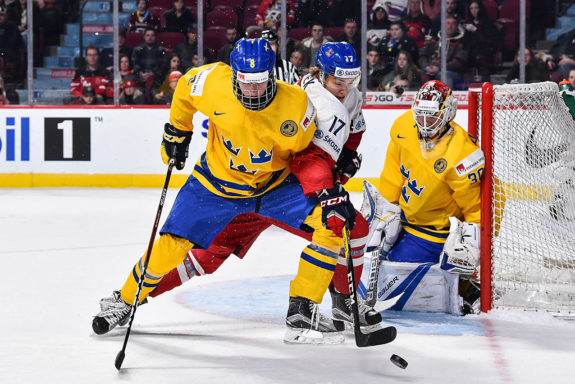Hockey is evolving and no change has been more apparent than the game’s speed. Over the years, we’ve seen different styles of play win the Stanley Cup. The tough, physical style of the Los Angeles Kings in 2012 and 2014, the skill and creativity of the Blackhawks in 2011, 2013 and 2015 and more recently in 2016 and 2017, the Pittsburgh Penguins and their blazing speed and skill.
Speed vs. Physicality
While some still argue that physical play and toughness wins Cups, others disagree. Speed is the key in the NHL, and no position has been victimized by this more than defensemen. Their job, difficult enough as it is, has been upped a degree of difficulty since the game became increasingly fast. It’s still necessary to clear the front of the net, take the body and win puck battles, but moving the puck up the ice quickly and flawlessly is the secret to success.

The Penguins were a curious case, as they had one of the weakest defense corps that’s ever been iced in a recent Stanley Cup Final. However, most of their defensemen, with the exception of Olli Maatta, were fairly good skaters. They were capable of breaking up plays, moving the puck up to one of their quick forwards and, just like that, out of the zone on the rush. The Penguins were not an overly physical team, neither were the Nashville Predators for that matter. But both teams could fluidly transition from defense to offense and capitalize off chances on the rush.
With the rising focus on youth and speed throughout the league, defensemen are now in charge of starting the attack.
How Has the Role Changed?
Long gone are the big, tough defensemen that would scare the opponents and constantly take the body. General managers are intrigued by the puck-moving, offensive-minded defensemen. Not convinced? Just ask Predators GM David Poile, who traded away his captain, Shea Weber, arguably one of the best defenders in the game, for a young puck-mover capable of generating plenty of offense in PK Subban. The defense corps in Nashville has become a point of reference for teams trying to build their back end (despite losing Ryan Ellis to injury).
Moving the puck up seems like such a simple task, yet only a handful of defensemen are able to do it without trouble. Erik Karlsson, who is often criticized, has become the poster-boy for puck-moving defensemen and is the type of player that has been changed the role of the defenseman in recent years. His quick, explosive skating paired with his ability to get the puck out of the zone via an outlet pass or simply skating it out is exemplary.

Around the league, we are seeing more and more young players grow their game in order to be quicker and transition the puck from defense to offense in the blink of an eye.
Of course, guys like Shea Weber, Ryan Suter, Brent Seabrook and others are valuable to their teams in the defensive zone. But in a game where speed has become crucial to success, teams are looking for defensemen who can make the perfect outlet pass. Not to say those guys can’t put the puck on a teammate’s stick, but there are better puck-movers around the league who don’t get the same recognition.
Up and Coming Puck-Movers
Looking at recent drafts, it’s easy to see that the trend of choosing puck-moving defensemen continues. Over the years, we’ve witnessed players like Noah Hanifin, Seth Jones, Aaron Ekblad, Ivan Provorov, Mikhail Sergachev, Zach Werenski and others follow that build. All are considered good skaters with good vision who are capable puck-movers who also play good defense. Obviously, some are still ‘works in progress’, but they were high draft picks for a reason.

In the upcoming draft, the consensus No. 1 pick, Rasmus Dahlin, is another player to follow that trend. He has dazzled scouts and analysts with his quick feet, soft hands, and excellent vision. A lot can change in a year, but Dahlin sure seems to be part of the future group of puck-moving defensemen drafted at the top of the board.
When looking at the defensemen who had the most time on ice last season, it’s easy to spot the trend as well. In the top-15, only Shea Weber and Ryan Suter are not “puck-movers”, even if they can do it better than the average d-man. If we jump back five years ago, we’ll find names like Dion Phaneuf, Nicklas Kronwall, Zdeno Chara, Andrei Markov, Dan Girardi, Fedor Tyutin and Dennis Wideman.
The era of smaller, agile, puck-moving defenseman has arrived.